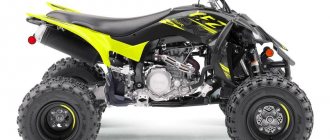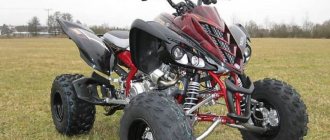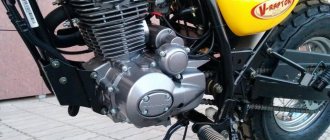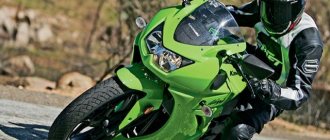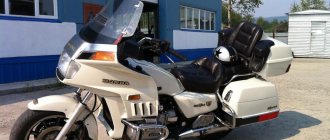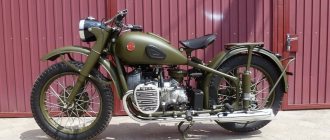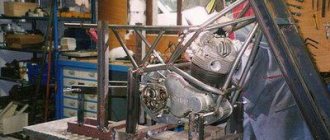Specifications
| Model | REGAL RAPTOR DD300E 2008 – LiFeng Group Co.,Ltd |
| Brand | Li Feng Group |
| Manufacturer country | China |
| Model year | 2008 |
| Motor vehicle class | Cruiser |
Engine | |
| engine's type | DD262MN two-cylinder in-line liquid-cooled engine, A6RTC/A7RTC spark plugs |
| Number of cylinders | 2 |
| Number of cycles | 4 |
| Ignition / Starting | CDI/electric |
| Engine volume, cm3 | 273 |
| Compression ratio | 10.2 :1 |
| Gas distribution system | OHC |
| Valves per cylinder | 2 |
| Cooling system | Liquid |
| Cylinder diameter and piston stroke, mm | 62 × 53 |
| Power, kW/hp @ rpm | 15.5 / 19,8 @ 8000 |
| Torque, Nm @ rpm | 22 @ 6500 |
| Carburetor (Qty. x Type) | constant-vacuum carburetor / 2 permanent carburetors discharge |
| Clutch | Multi-disc, oil bath |
| Engine oil | SAE 10W/40 API SG |
| Lubrication system | Forced lubrication |
| Exhaust gas cleaning | Catalytic converter / ENTE357-2 |
| Maximum speed, km/h | 115 |
| Fuel tank volume, l | 15,9 |
| Type | 5-speed, manual |
| Main gear ratio | 3.631 |
| 1st gear | 1:2.846 |
| 2nd gear | 1:1.777 |
| 3rd gear | 1:1.333 |
| 4th gear | 1:1.083 |
| 5th gear | 1:0.913 |
| Final gear ratio | 2.846 |
| Number of gears | 5 |
| Front suspension | Telescopic |
| Rear suspension | Pendulum |
| Front brakes | Disc, hydraulic |
| Rear brakes | Disc, hydraulic |
| Drive unit | Chain |
| Wheelbase, mm | 1860 |
| Seat height, mm | 560 |
| Ground clearance, mm | 150 |
| Front wheels | Chromium alloy |
| Rear wheels | Chromium alloy |
| Front tires | 80/90-21 |
| Rear tires | 160/80-16 |
| Length, mm | 2550 |
| Width, mm | 900 |
| Height, mm | 1080 |
| Dry weight, kg | 150 |
| Number of seats | 2 |
| Maximum load (front/rear), kg | 183 |
| Accumulator battery | 12V / 9Ah |
| Price | 93,000 rubles |
Helicopter TTR RAPTOR 50 +ICE
"Chaos"? "Funnel"? “Tick-tock” with altitude gain? Yes, anything! With the Raptor 50 Titan, you can realize your wildest 3D piloting ambitions and have great fun! You can fit 620mm blades on it thanks to the extended tail boom. You can control the tail rotor with extreme precision by reducing the tail thrust with the tail servo mounted. Finally, you can simply enjoy its optimal power-to-weight ratio and the best handling in the entire range in this class.
Russian instructions for Raptor 50 Titan (3.43 MB) >>
The RAPTOR 50 Titan ARF helicopter is supplied 90% pre-assembled. This RC helicopter model is intended for both novice pilots and pilots who already have basic skills in flying an RC helicopter and want to develop 3D piloting skills.
Click on the image to enlarge:
FEATURES: — The kit is 90% preassembled. The radio-controlled model of the RAPTOR 50 Titan helicopter, designed by the famous pilot Shigetada Taya, can perform any elements of 3D piloting, thanks to the introduction into the design of this model of all the best solutions from previous models and new solutions that have improved flight characteristics and controllability: - Pull-Push dual thrust system ( push-pull), improving control accuracy - Extended tail boom - The tail servo is located on the tail boom, which shortens the length of the tail rod and has a beneficial effect on the control accuracy of the tail rotor - Reinforced, more durable main rotor shaft - Reinforced clutch bearings - Steel rods - Stickers with new design
Servo tail mount (click to enlarge):
The tail rotor is driven by a reinforced toothed belt. The Raptor 50 Titan kit includes: a set of parts for assembling the model, an exhaust pipe for the engine, 600mm wooden symmetrical blades (already balanced at the factory), cockpit stickers, assembly instructions.
INCLUDES: 90% pre-assembled RAPTOR 50 Titan ARF RC helicopter with installed PRO-50H engine, muffler and fuel tank, step-by-step assembly instructions (in English).
Push-pull rod for collective pitch control (click to enlarge):
ADDITIONALLY REQUIRED: 6 or more channel radio control system with 5 servos and on-board battery 1000 mA, or similar, gyroscopic system, glow plug for the engine, collet with battery for heating the spark plug, electric starter, adapter shaft for electric starter, mechanical or electric pump for pumping fuel into the fuel tank from a filling container, fuel, tools for assembly.
Engine PRO-50H(R) (click to enlarge):
SPECIFICATIONS: Length: 1220 mm Width: 140 mm Height: 400 mm Main rotor diameter with 600 mm blades: 1345 mm Main rotor diameter with 620 mm blades: 1385 mm Tail rotor blade diameter: 237 mm Gear ratio: (standard) : 1:8.5: 4.56 / (optional) : 1:8.73:4.56 Weight: 3000g
Russian instructions for Raptor 50 Titan (3.43 MB) >>
COMMENTS: Discuss this model on the R/C forum >>
Instructions
- Safe operation.
- Safety regulations.
- Protective equipment.
- Loading cargo.
- Description.
- Functions.
- Control.
- Preliminary inspection.
- Engine starting.
- Run-in.
- Exploitation.
- Service.
- Selecting and replacing a spark plug.
- Replacing the air filter.
- Inspect and adjust the throttle.
- Clutch adjustment.
- Adjusting and lubricating the chain.
- Battery maintenance.
- Cooling system.
- Motorcycle washing.
- Notes
T-50 vs F-22 Raptor. Comparative analysis of fifth generation fighters in Russia and the USA
Aviation has always excited the minds of people, and combat fighters are rightfully considered the crown of its development. Now that the world is once again unsettled, and many politicians are increasingly using the expression “Second Cold War,” it is interesting to compare the arsenals of potential “friends.” The fashionable expression “fifth generation product” first appeared in military aviation. Let's try to figure out what it means.
In fact, the term has been around for many years. For the first time, the military and designers of the USSR and the USA thought about such a fighter at the very beginning of the 1980s. The main features of such an aircraft were the so-called three “Cs”:
- super maneuverability;
- ultra-low visibility;
- supersonic flight.
Phantoms of the Cold War
Programs to create 5th generation fighters started almost simultaneously in the USA and the USSR. It was expected that the fighters would enter service with the air force as early as the 1990s. However, the Soviet Union collapsed, and in 2000, due to lack of funding, the multirole front-line fighter program (1.42) was frozen and terminated. The only flight model built - “product 1.44” - made only two flights and was mothballed.
In parallel, in the USSR and then in Russia, work was carried out on another experimental aircraft with a forward-swept wing, the S-37 Berkut (according to NATO codification - Firkin). The fighter was planned to be equipped with the most modern systems: an onboard radar with an active phased array antenna (AFAR) with an increased detection range, a rear-view radar, an optical-electronic complex, and a wide range of weapons to perform air interception functions and engage sea and ground targets. The S-37, like the MiG-1.44, was equipped with AL-41F engines. The Berkut program also did not go beyond the prototype, but served as a flying platform for the design of a new 5th generation aircraft.
F-22A fighter
Meanwhile, the United States managed to seriously get ahead of Russian developers. As part of the ATF (Advanced Tactical Fighter) program, by 1990 the first prototypes of new fighters, created on a competitive basis, were already ready. As a result of the tender, in which two pairs of prototypes participated, the winner was the project of the Lockheed company (now Lockheed Martin), which received the designation F-22 Raptor in the series. The contract for the production of engines was concluded with the company that developed the F119-PW-100 product.
Initially, it was planned to build nine pre-production single-seat F-22A and two two-seat F-22B (the latter were later abandoned). During flight testing in 1992, a prototype crashed during landing at Edwards Air Force Base. After that, over the course of five years, major changes were made to the design of the fighter. The aircraft in its final form was designed by 1995, in the middle of which the assembly of an experimental aircraft began, which made its first flight on September 7, 1997. Serial production of the Raptors began in 2000, but they began to enter service with the US Air Force only three years later.
Dear and very secret
The F-22 program turned out to be one of the most expensive in aviation history. According to experts, the development and serial production of a significantly reduced number of aircraft (187 instead of the initially planned purchase of 750) amounted to 62 billion dollars, or about 339 million per 1 serial fighter. At the moment, serial production of the aircraft has been completed, and they are in service with 8 air wings of the US Air Force.
F-22A assembly line (currently discontinued)
Today, the F-22A Raptor is the only 5th generation serial fighter in the world that implements the above-mentioned main features of aircraft of this type. In addition, it is characterized by high automation of the processes of piloting, navigation, target detection and weapon use. The aircraft is equipped with an airborne active phased array radar AN/APG-77. The main armament is located in three internal compartments - 6 medium-range air-to-air missiles AIM-120 AMRAAM (from 50 to 100 km) in the central ventral compartment and 2 short-range air-to-air missiles AIM-9 Sidewinder (up to 30 km) in two side compartments.
Launch of the AIM-120 AMRAAM aircraft missile
In addition, the vehicle has four suspension points under the wings, which can be used to accommodate external fuel tanks and aircraft missiles. However, these weapon options dramatically increase the visibility of the aircraft and significantly reduce its maneuverability.
F-22A fighter with open weapons bays
The appearance of the F-22 was formed during the Cold War: its priority task was to gain air superiority. However, fighting ground targets and participating in local conflicts in third world countries were not among the Raptor’s tasks at that time. The use of high-precision JDAM-type ammunition on it began only in 2005. In 2012, the US Air Force received the first modernized F-22 aircraft, which had improved ground-fighting capabilities and was armed with GBU-29 SDB (Small Diameter Bomb) guided bombs. In addition, it is currently not capable of using the latest modifications of air-to-air missiles: short-range AIM-9X Sidewinder and medium-range AIM-120 DAMRAAM (killing range up to 180 km). These types of missiles will be available to arm the F-22 starting in 2015 and 2018, respectively.
Testing the use of short-range aircraft missiles AIM-9X
Training and combat use of the F-22
Given the secrecy of the technology used in the F-22 program, the United States has long not allowed the deployment of fighter jets outside the country. Only in 2007 did they begin to be based abroad for the first time - on the island of Okinawa (Japan). In 2014, “Japanese” aircraft participated in exercises with the Royal Malaysian Air Force, which included the Russian-made Su-30 MKM 4++ generation multirole fighters (according to NATO codification – Flanker-C). In 2007, fighter jets intercepted for the first time a pair of Russian Tu-95MS strategic bombers (NATO codification: Bear) off the coast of Alaska.
At first they refused to deploy F-22s at American air bases in the Middle East. However, already in 2009, aircraft appeared in the UAE based on AlDhafra. In March 2013, the fighter reportedly intercepted an Iranian F-4 Phantom II, which in turn was attempting to intercept an MQ-1 Predator attack drone flying along the coast. According to press reports, it was only in September 2014 that the United States decided to use the F-22 to strike ground positions of Islamic State militants located in Syria. During this raid, fighters used 1,000-foot bombs, guided by GPS signals. However, the US authorities considered the use of such expensive aircraft in the fight against rebels to be inappropriate.
What's in Russia?
As already mentioned, for a number of reasons (primarily due to the collapse of the USSR) in Russia the development of a 5th generation fighter was much slower. However, this made it possible to rethink the goals and objectives of the program, because the 1990s and 2000s were not in vain for the Russian aviation industry. During this period, very successful multifunctional intermediate generation fighters appeared - 4++ Su-30MK (according to NATO codification - Flanker-C) in various versions. They have become export hits around the world and form the backbone of the air forces of India, China, Malaysia, Vietnam, Venezuela, Indonesia and other countries.
Su-35S (according to NATO codification – Flanker-E+)
As it turns out, the key to success in modern aviation is a suitable aerodynamic platform and modern on-board radars coupled with flight and navigation systems, as well as powerful jet engines with all-angle thrust vectoring and a wide range of weapons of all classes. A further development in this direction was the appearance of the Su-35S fighter (according to NATO codification – Flanker-E+), which was created in the interests of the Russian Air Force and should be the main multi-role fighter until the advent of 5th generation production aircraft.
Long-term construction has moved forward
Taking into account the difficult economic conditions, as well as the experience and costs of the United States in creating the F-22, Russia decided to develop a middle-class fighter - in size it was supposed to be between the light MiG-29 (according to NATO codification - Fulcrum) and the heavy Su-27 (according to NATO codification – Flanker). At the same time, the domestic fighter must surpass all Western analogues and provide a variety of combat capabilities. Based on these requirements, in 2001 a tender was announced for the development of a promising front-line aviation complex (PAK FA). She won the competition with the T-50 project.
First flight of the T-50–1. Photo: Sukhoi Holding Holding Company
The construction of prototypes and preparation for serial production were carried out at the aircraft plant in Komsomolsk-on-Amur. The experimental T-50 made its first flight in January 2010. Currently, 5 samples are already being tested. In 2014, state tests of the fighter began at the Ministry of Defense training ground in Akhtubinsk, where, simultaneously with test pilots, the military began mastering the vehicle. According to the data, as part of preliminary tests of the T-50, assessments were carried out of aerodynamic characteristics, stability and controllability, dynamic strength, as well as checking the functioning of the complex of on-board equipment and aircraft systems.
Flight of a pair of T-50s. Photo: Sukhoi Holding Holding Company
T-50 equipment and weapons
Since the summer of 2012, two aircraft have been testing the latest airborne radar system with AFAR, as well as a promising optical-electronic detection system.
A prototype of an airborne radar with AFAR at the MAKS-2009 air show
Aircraft refueling and super-maneuverability mode are already being tested. It is planned to use the new “117” product as the main engine for the T-50, which will have higher performance than the previously created AL-41F engine.
Engine AL-41F1
Unlike the F-22, the Russian fifth-generation fighter will be multi-role from the very beginning. On the T-50, an optical-electronic system will be integrated into the on-board radar, which is still not available on its American counterpart. The T-50 is planned to have a much wider range of weapons. As an air combat weapon, the T-50 will carry several RVV missiles (according to NATO codification - AA-12 Adder) in short, medium and long range modifications. Moreover, the latter is capable of hitting enemy aircraft at a distance of up to 200 km - at least this is reported in promotional materials at MAKS-2013. There are no analogues to it in the world today.
Long-range aviation missile RVV-BD
Air-to-ground missiles that the new fighter could be armed with were also demonstrated at the exhibitions. One of these may be the new Kh-38ME aircraft missile (according to NATO codification - AA-11 Archer). It is designed on a modular basis, which allows the use of different combined guidance systems. The latter may include an inertial system and options for final precision guidance - based on homing heads (laser, thermal imaging, radar type) or satellite navigation. Depending on the modification, the missile is equipped with a high-explosive fragmentation, penetrating or cluster warhead.
It is expected that the first production T-50 fighters will begin to enter service with the Russian Air Force in 2016, and by 2022 their number will increase to 55 units.
Flight of three T-50s during MAKS 2013
T-50 vs F-22 Raptor
Although the Russian 5th generation fighter is somewhat late, it may ultimately be significantly superior to its American counterpart. Let's try to summarize the comparison of the two machines.
Value for money
The American aircraft was designed during the Cold War and, as time has shown, turned out to be unclaimed and very expensive. Russia used the gap from the United States wisely - the experience of creating the F-22, its operation and capabilities were assessed. The PAK FA will be a multi-role fighter with a wide range of missions.
Maneuverability
Overly carried away by the desire for stealth, the United States created aircraft that were incapable of super-maneuverability and poorly suited for close combat. The T-50 prototype publicly demonstrates aerobatic maneuvers, and in full configuration with basic all-aspect engines will demonstrate true super-maneuverability.
Dominance in the air and on the ground
The F-22 was planned as an air superiority fighter using only air-to-air missiles at extremely long and medium ranges. Its use as a carrier of precision weapons to destroy ground targets became possible much later. At the same time, the F-22 can use an extremely limited set of weapons with guidance based on GPS signals. The lack of its own optical-electronic system does not allow the use of a wider range of missiles and guided bombs.
The T-50 will immediately have all the capabilities to hit air and ground targets, including such specific ones as enemy air defense radars, while the American HARM anti-radar missile does not fit the dimensions of the F-22’s internal weapons bay. The presence of super-maneuverability modes and effective short-range missiles of the RVV-MD type will give the T-50 an advantage in close maneuver combat. Possession of ultra-long-range RVV-BD missiles will allow the T-50 to hit the enemy at a distance at which he cannot respond.
In conclusion, here is a quote from a person who can hardly be suspected of bias. “The analysis data that I have seen on the PAK FA indicates that the aircraft has a rather complex design, which is at least as good as, and according to some experts, even superior to, American fifth-generation aircraft,” said former US Air Force intelligence chief Gen. Lieutenant Dave Deptula.
Regal Raptor DD50E. Start
Even as a child, I had three dreams: Guitar, tattoo and motorcycle.I bought a guitar during my school years, got a tattoo in my first years of college, but I still couldn’t get enough of a motorcycle.
It all started back in May 2012, when I was simply drawn to the topic of a motorcycle. The question arose of what to buy so that it would be 1-cheap, 2-suitable for a beginner and 3-not a stool.
In general, initially I didn’t consider options larger than a moped because I really didn’t want to bother with a category A license (especially since at that time I was already actively studying for category B). There was a very small choice left from all sorts of different scooters and Soviet heritage. I dismissed both immediately. I never liked scooters, and I didn’t want to get involved with Soviet technology because I have to mix oil into gasoline, and I’m too lazy to do that.
In general, I thought for a long time and practically decided to take the ZID Pilot with the new 4T engine, but then the most banal thing happened - the beginning of the season and prices skyrocketed. Somehow, quite by accident, I came across a MOTO magazine of the year, like 2004 or 2005, and on the cover there was an advertisement for IronEagle. Here it is, I thought - a moped, but it looks so grown-up!
No sooner said than done, I found a seller, took the money, and went after work to look.
Evening, sunset, South Butovo. At the exit from the metro, I was met by a group of informals in as many as three Raptors, two of which looked like they had been tuned with a sledgehammer. I sat down with one and went to the habitat of the owner of my future animal.
In general, I don’t know how, but the owner of this monster persuaded me to buy it, and even managed to give me a bag of all sorts of scrap in the bargain.
My firstborn looked at least pathetic at the time of purchase (see photo).
I left them at one in the morning, having managed to pour a can of beer into myself in celebration (it’s good that no more).
My path ran from South Butovo to the center of Moscow, or rather to Arbat.
The only thing that made me happy was that the moped had absolutely no engine problems (well, almost none) and the brakes worked. I was not happy that the electrics were dead, i.e. I was driving without any lights at all, there was no speedometer, and the last time I drove something on two wheels was around the time I bought my first guitar (see the beginning of the post).
I found out where to go (my phone was dead, so there was no navigator) and drove off. The first half hour passed without incident, I stopped at a gas station, filled the tank full and drove on. The first jokes began when I got to the Moscow Ring Road. There was no chance to bypass the Moscow Ring Road because my geographical critinism would have led me God knows where if I had not stuck to major highways.
On the Moscow Ring Road, the moped suddenly sneezed and died. I’m standing on the side of the road, smoking and wondering what to do next. I learned the reason for this behavior much later and will write about it in future posts. After about 10 minutes, he kicked the kick and the moped came to life (quickly, quickly to Varshavka, to hell with the Moscow Ring Road).
Then everything is somehow quiet and peaceful. I rode to the center for 2 hours. The cops didn’t pay attention to me, the moped didn’t let me down, and all sorts of “necessary” spare parts that the former owner carefully shoved onto my back hurt me to the point of bruises, so I periodically stopped to smoke and warm up. It's actually very cold at 4 o'clock in the morning in May))
In short, at home I received a scolding from my wife for not picking up the phone (how can I pick it up if the phone is dead and there’s not a soul on the street?) and went to bed.
Read about how the moped came back to life in the following articles, but for now I’ll take my leave.
